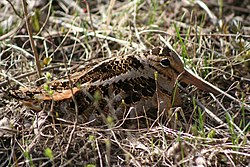| Woodcock | |
|---|---|
 | |
| American woodcock | |
| Scientific classification | |
| Kingdom: | Animalia |
| Phylum: | Chordata |
| Class: | Aves |
| Order: | Charadriiformes |
| Family: | Scolopacidae |
| Genus: | Scolopax Linnaeus, 1758 |
| Type species | |
| Scolopax rusticola Linnaeus, 1758 | |
| Diversity | |
| 8 living species | |
The woodcocks are a group of eight very similar living species of sandpipers in the genus Scolopax. The genus name is Latin for a snipe or woodcock, and until around 1800 was used to refer to a variety of waders. [1] The English name is first recorded in about 1050. [2] According to the Harleian Miscellany, a group of woodcocks is called a "fall". [3]



